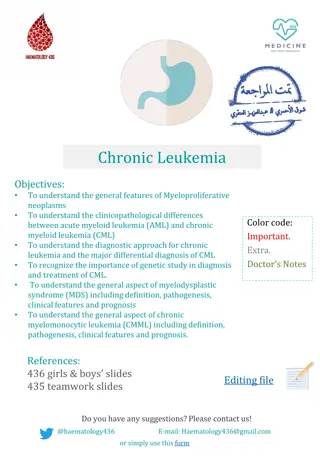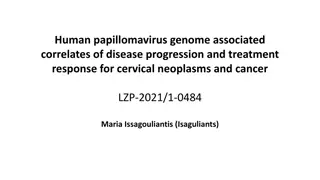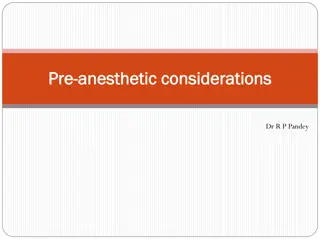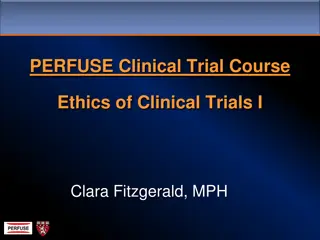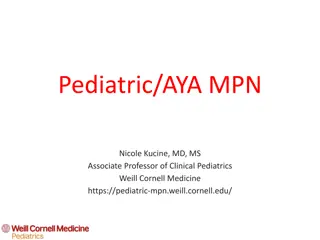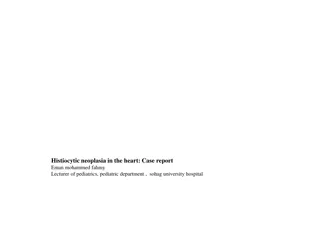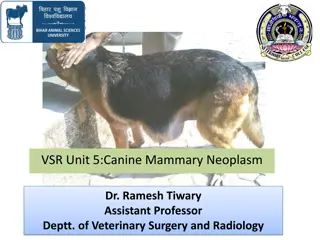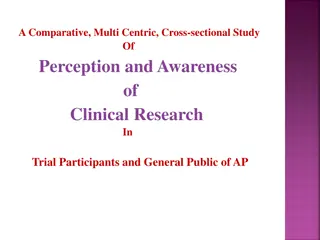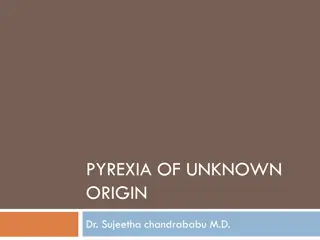Understanding Myeloproliferative Neoplasms: Overview and Clinical Considerations
Myeloproliferative neoplasms (MPNs) include a group of disorders characterized by overproduction of blood cells. The WHO classification outlines eight disorders with varied clinical presentations and potential for transformation. These disorders, such as CML, CNL, and PV, exhibit significant phenotypic heterogeneity with underlying genetic mutations like JAK2 activation. Primary myelofibrosis, the least common MPN, primarily affects older men and can present with marrow fibrosis and splenomegaly. Accurate diagnosis can be challenging due to overlapping features with other conditions.
Download Presentation

Please find below an Image/Link to download the presentation.
The content on the website is provided AS IS for your information and personal use only. It may not be sold, licensed, or shared on other websites without obtaining consent from the author. Download presentation by click this link. If you encounter any issues during the download, it is possible that the publisher has removed the file from their server.
E N D
Presentation Transcript
MYELOPROLIFERATIVE NEOPLASMS DR. NITHYA RAMANUJAN JR2 GENERAL MEDICINE
WHO classification of the chronic myeloproliferative neoplasms (MPNs) Eight disorders share an origin in a hematopoietic cell overproduction of one or more of the formed elements of the blood without significant dysplasia predilection to: extramedullary hematopoiesis myelofibrosis transformation to acute leukemia(varying rates)
significant phenotypic heterogeneity chronic myelogenous leukemia (CML) chronic neutrophilic leukemia (CNL) myeloid phenotype chronic eosinophilic leukemia (CEL) polycythemia vera (PV) primary myelofibrosis (PMF) erythroid or megakaryocytic essential thrombocytosis (ET) hyperplasia Latter three disorders - capable of transforming into each other
phenotypic heterogeneity has a genetic basis CML-t[9;22][q34;11] CNL -t(15;19) translocation CEL -deletion or balanced translocations of PDGFR gene High rates of leukemic transformation Natural history-years PV, PMF, ET -driver mutations that directly or indirectly activate JAK2 (tyrosine kinase -erythropoietin and thrombopoietin receptors and G-CSF receptor) Transformation to AL is uncommon in absence of chemo Decades
PRIMARY MYELOFIBROSIS Primarily affect men, 6th decade or later Acute or malignant myelofibrosis occurs in any age Chronic PMF(idiopathic myelofibrosis,agnogenic myeloid metaplasia, or myelofibrosis with myeloid metaplasia) Least common chronic MPN
Clonal disorder of a multipotent hematopoietic progenitor cell of unknown etiology Marrow fibrosis, extramedullary hematopoiesis, splenomegaly Difficult to diagnosis in the absence of a specific clonal marker as myelofibrosis f/o both PV and CML splenomegaly variety of benign & malignant disorders
ETIOLOGY Unknown Nonrandom chromosome abnormalities such as 9p, 20q , 13q , trisomy 8 or 9, or partial trisomy 1q are common No specific cytogenetic abnormality identified JAK2 V617F ~ 50% of PMF patients Mutations in thrombopoietin receptor Mpl ~ 5% Most of the rest -mutations in the calreticulin gene (CALR)(alter the carboxy-terminal portion of the gene product)
Degree of myelofibrosis & extent of extramedullary hematopoiesis are not related Fibrosis- associated with overproduction of TGF- and tissue inhibitors of metalloproteinases Osteosclerosis- associated with overproduction of osteoprotegerin (osteoclast inhibitor) Marrow angiogenesis- increased production of VEGF Fibroblasts in PMF are polyclonal
CLINICAL FEATURES Asymptomatic Usually detected- splenic enlargement and/or abnormal blood counts during a routine examination Common presenting complaints- night sweats, fatigue, and weight loss Blood smear- characteristic features of extramedullary hematopoiesis teardrop-shaped red cells nucleated red cells Myelocyte Promyelocytes Myeloblasts may be present
Anemia- mild initially Leukocyte and platelet counts- normal or increased (can be depressed) Mild hepatomegaly may accompany splenomegaly Isolated lymphadenopathy suggest another diagnosis serum LDH and ALP levels LAP score -low, normal, or high Marrow- inaspirable due to the myelofibrosis
Bone x-rays:osteosclerosis Exuberant ascites extramedullary portal, pulmonary, or intracranial HTN hematopoiesis intestinal or ureteral obstuction pericardial tamponade spinal cord compression skin nodules Splenic enlargement, sufficiently rapid splenic infarction [fever, pleuritic chest pain] Hyperuricemia and secondary gout
DIAGNOSIS Clinical picture-characteristic of PMF Clinical features can also be seen in PV or CML Massive splenomegaly -masks erythrocytosis in PV Intraabdominal thrombosis in PMF -unrecognized PV In some PMF patients erythrocytosis is seen Many other disorders have features that overlap with PMF; diagnosis of exclusion
Teardrop-shaped red cells, nucleated red cells, myelocytes, promyelocyte EM hematopoiesis Leukocytosis, thrombocytosis with large and bizarre platelets, circulating myelocytes-suggest MPN Splenomegaly(may sufficiently massive) portal hypertension, variceal formation Marrow- inaspirable due to increased marrow reticulin Marrow biopsy- a hypercellular marrow with trilineage hyperplasia, esp. increased numbers of megakaryocytes in clusters and with large, dysplastic nuclei
No characteristic bone marrow morphologic abnormalities- distinguish PMF &other chronic MPNs Autoimmune abnormalities - immune complexes, antinuclear antibodies, rheumatoid factor, or a positive Coombs test Cytogenetic analysis of blood - to exclude CML,for prognostic purposes (complex karyotype abnormality- poor prognosis) Circulating CD34+ cells is markedly increased in PMF (>15,000/ L)
50% of PMF patients- JAK2 V617F mutation (often homozygous) usually older, higher hematocrits Patients with MPLmutation more anemic,lower TC Somatic mutations in exon 9 of the calreticulin gene (CALR)- majority of patients with PMF and ET(lack above mutations)clinical course is more indolent
COMPLICATIONS Marrow failure, transfusion-dependent anemia Organomegaly (extramedullary hematopoiesis) PMF- evolve from a chronic phase to an accelerated phase (constitutional symptoms, increasing marrow failure) 10% of patients spontaneously transform to an aggressive form of acute leukemia (therapy is usually ineffective)
Prognostic factors for disease acceleration- complex cytogenetic abnormalities, thrombocytopenia, transfusion-dependent anemia Mutations in ASXL1, EZH2, SRSF2, and IDH1/2 genes- risk factors for early death or transformation to AL
Treatment No specific therapy Causes of anemia inffective erythropoiesis uncompensated by splenic extramedullary hematopoiesis hemodilution due to splenomegaly splenic sequestration blood loss secondary to thrombocytopenia or portal hypertension folic acid deficiency systemic inflammation autoimmune hemolysis
EPO - worsen splenomegaly, ineffective if the serum EPO level >125 mU/L Glucocorticoids- ameliorate anemia, constitutional symptoms (fever, chills, night sweats, anorexia, weight loss) Glucocorticoids + low-dose thalidomide effective Thrombocytopenia (impaired marrow function, splenic sequestration, or autoimmune destruction) -respond to low- dose thalidomide and prednisone
Splenomegaly -abdominal pain, portal hypertension, easy satiety, and cachexia Splenectomy a/w postop complications mesenteric venous thrombosis Hemorrhage rebound leukocytosis and thrombocytosis hepatic extramedullary hematopoiesis no amelioration of anemia or thrombocytopen Also increases the risk of blastic transformation
Splenic irradiation(best)- temporarily palliative significant risk of neutropenia Infection subsequent operative hemorrhage (if splenectomy attempted) Allopurinol- control significant hyperuricemia Local irradiation- bone pain
Pegylated IFN- ameliorate fibrosis in early PMF (in advanced d/s, exacerbate bone marrow failure) Ruxolitinib (JAK2 inhibitor)- effective in reducing splenomegaly alleviating constitutional symptoms prolonging survival Major side effect-anemia and thrombocytopenia (dose- dependent, with time, anemia stabilizes, thrombocytopenia may improve
Allogeneic bone marrow transplantation only curative treatment for PMF considered in younger patients, older patients with high risk disease
ESSENTIAL THROMBOCYTOSIS Essential thrombocythemia, idiopathic thrombocytosis, primary thrombocytosis, and hemorrhagic thrombocythemia Clonal hematopoietic stem cell disorder a/w mutations in JAK2 (V617F), MPL, and CALR Overproduction of platelets without a definable cause Incidence of 1 2/100,000 Female predominance (association with mutations)
Occur at any age in adults Often without symptoms or disturbances of hemostasis MPN driver mutations distinguish 90% of ET patients from the more common non clonal, reactive forms of thrombocytosis Mutation-negative ET patients -have an hereditary form of thrombocytosis
ETIOLOGY Megakaryocytopoiesis &platelet production depend on thrombopoietin and its receptor MPL Early megakaryocytic progenitors -require IL-3 & stem cell factor for optimal proliferation Their subsequent terminal development -enhanced by the chemokine stromal cell-derived factor 1 (SDF-1) Thrombopoietin - primarily in the liver, lesser extent in other organs (most importantly the bone marrow)
Inverse correlation- between platelet count and plasma thrombopoietin Plasma thrombopoietin level -controlled by the size of the megakaryocyte progenitor cell pool Thrombopoietin also enhances the reactivity of their end- stage product, the platelet
CLINICAL FEATURES Incidentally by abn. platelet count on routine medical evaluation Hemorrhagic tendancies (easy bruising) Thrombotic tendencies (microvascular occlusive events- erythromelalgia, ocular migraine, TIA Mild splenomegaly Significant splenomegaly-s/o another MPN (PV, PMF, or CML)
Anemia is unusual Mild neutrophilic leukocytosis Blood smear number of platelets (may be very large) May cause hyperkalemia- release of platelet K+ upon blood clotting (test tube artifact, not a/w ECG abnormalities) Arterial oxygen measurements inaccurate unless thrombocythemic blood is collected on ice
PT, APTT- normal Prolonged BT and impaired platelet aggregation platelet count-hinder marrow aspiration Marrow biopsy- megakaryocyte hypertrophy & hyperplasia, increase in marrow cellularity If marrow reticulin is increased another diagnosis
Absence of stainable iron needs explanation Iron deficiency alone can cause thrombocytosis Absent marrow iron in presence of hypercellular marrow- feature of PV Nonrandom cytogenetic abnormalities occur in ET, uncommon
DIAGNOSIS Thrombocytosis -broad variety of clinical disorders (many have inflammatory cytokine production) JAK2 V617F mutation 55% ET JAK2 V617F is absent- cytogenetic evaluation mandatory to find thrombocytosis due to CML (Ph chromosome ) myelodysplastic disorder (the 5q syndrome)
If Ph chromosome cytogenic study ve FISH analysis for bcr-abl is preferred assay Bcr-abl translocation can be present in the absence of the Ph chromosome bcr-abl reverse transcriptase PCR a/w false-positive results
In JAK2 mutation ve ptsCALR (type 1 or type 2) : 36% MPL mutations : 4% Significant splenomegaly-suggest another MPN, hence red cell mass determination needed ET can evolve into PV (usually in women with JAK2 V617F) or PMF (usually in men with type 1 CALR mutations) Over years due to clonal evolution or succession
Sufficient overlap of the JAK2 V617F neutrophil allele burden b/w ET and PV Only a red cell mass and plasma volume determination- distinguish PV from ET
COMPLICATIONS No need to intervene unless the platelet count is >1 106/ L Very high platelet counts- a/w hemorrhage d/t acquired von Willebrand s disease Neurologic problems in ET migraine-related respond only to lowering of platelet count Erythromelalgia respond to PLT COX-1 inhibitors (aspirin, ibuprofen)
TREATMENT Elevated platelet count, asymptomatic patient, without cardiovascular risk factors or tobacco use no therapy When platelet count rises above 1 10^6/ l substantial quantity of high molecular-weight von Willebrand multimers are removed from the circulation and destroyed by the enlarged platelet mass acquired von Willebrand s disease Identified by a reduction in ristocetin cofactor activity Aspirin could promote hemorrhage Bleeding -rarely spontaneous Usually responds to -aminocaproic acid (given prophylactically before and after elective surgery) Plateletpheresis - temporary and inefficient remedy
ET patients treated with 32? or alkylating agents -risk of developing AL Combining these with hydroxyurea increases the risk If symptoms refractory to salicylates pegylated IFN- quinazoline derivative used to reduce the platelet count Anagrelide significant side effects hydroxyurea
Hydroxyurea + aspirin : effective than anagrelide + aspirin, for prevention of TIA as hydroxyurea is an NO donor risk of GI bleeding higher with aspirin + anagrelide Normalizing the platelet count not prevent either arterial or venous thrombosis Pegylated interferon can produce a complete molecular remission in some ET patients
CHRONIC NEUTROPHILIC LEUKEMIA (CNL) Clonal proliferation of mature neutrophils with few or no circulating immature granulocytes In 2013, CNL was a/w activating mutations of gene- CSF3R encoding for the receptor for G-CSF (a/k/a CSF3) Rare , with <200 reported cases Median age at diagnosis 67 years Equally prevalent in both genders Median survival is 2 years
Patients may be asymptomatic Constitutional symptoms, splenomegaly, anemia, thrombocytopenia Causes of death- leukemic transformation, severe cytopenias, marked treatment-refractory leukocytosis Pathogenesis CSF3 -main growth factor for granulocyte proliferation and differentiation Recombinant CSF3 is used for the treatment of severe neutropenia, including severe congenital neutropenia (SCN) Some patients with SCN acquire CSF3R mutations
Diagnosis Exclusion of the more common causes of neutrophilia (infections, inflammatory processes)
Treatment palliative and suboptimal in efficacy ASCT- reasonable to consider in presence of symptomatic disease, esp. in younger patients Cytoreductive therapy with hydroxyurea good Response to hydroxyurea therapy is often transient Interferon - alternative drug Ruxolitinib (a JAK1 and JAK2 inhibitor) Response is often incomplete and temporary
Chronic Eosinophilic Leukemia, Not Otherwise Specified (CEL-NOS) Subset of clonal eosinophilia neither molecularly defined nor classified as an alternative clinicopathologically assigned myeloid malignancy Used strictly in patients with an HES phenotype who display either a clonal cytogenetic/molecular abnormality or excess blasts in the BM or PB WHO definition presence of 1.5 109/L AEC + either presence of myeloblast excess (either >2% in PB or 5 19% in BM) evidence of myeloid clonality
Cytogenetic abnormalities in CEL, other than those a/w molecularly defined eosinophilic disorders trisomy 8 (most frequent) t(10;11)(p14;q21) t(7;12)(q11;p11) CEL-NOS -no response to imatinib Treatment not different from similar MPNs ASCT for transplant-eligible patients with poor risk factors



